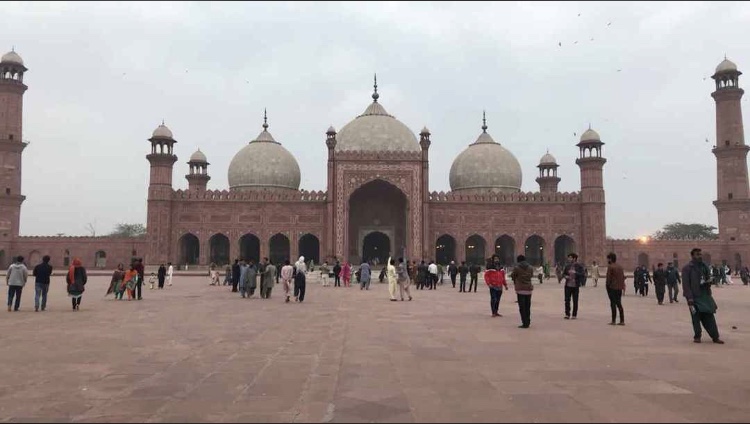Daily Celestial Challenge ( Wednesday - Structures )
BADSHAHI MOSQUE
The Badshahi Mosque was built in 1673 by the Mughal Emperor Aurangzeb in Lahore, Pakistan. It is one of the city's best known a major tourist attraction epitomising the beauty and grandeur of the Mughal era.

HISTORY
SIKH ERA
On 7 July 1799, the Sikh army of Ranjit Singh took control of Lahore. After the capture of the city, Maharaja Ranjit Singh used it as vast courtyard as a stable for his army horses, and its 80 Hujras (small study rooms surrounding the courtyard) as quarters for his soldiers and as magazines for military stores. In 1818, he built a marble edifice in the Hazuri Bagh facing the mosque, known as the Hazuri Bagh Baradari, which he used as his official royal court of audience. Marble slabs for the baradari may have been plundered by the Sikhs from other monuments in Lahore.
During the First Anglo-Sikh War in 1841, Ranjit Singh's son, Sher Singh, used the mosque's large minarets for placement of zamburahs or light guns which were used to bombard the supporters of Chand Kaur, who had taken refuge in the besieged Lahore Fort. In one of these bombardments, the fort's Diwan-e-Aam (Hall of Public Audience) was destroyed, but was subsequently rebuilt by the British. During this time, Henri de La Rouche, a French cavalry officer employed in the army of Sher Singh, also used a tunnel connecting the Badshahi mosque to the Lahore fort to temporarily store gunpowder.
In 1848, the Samadhi of Ranjit Singh was built for the Sikh ruler Ranjit Singh at a site immediately adjacent to the mosque after his death.
BRISTISH RULE
In 1849 the British seized control of Lahore from the Sikh Empire. During the British Raj, the mosque and the adjoining fort continued to be used as a military garrison. The 80 cells built into the walls surrounding the its vast courtyard were demolished by the British after the Indian Rebellion of 1857, so as to prevent them from being used for anti-British activities. The cells were replaced by open arcades known as dalans.
Because of increasing Muslim resentment against the use of the mosque as a military garrison, the British set up the Badshahi Mosque Authority in 1852 to oversee the restoration and to re-establish it as a place of religious worship. From then onwards, piecemeal repairs were carried out under the supervision of the Badshahi Mosque Authority. The building was officially handed back to the Muslim community by John Lawrence, who was the Viceroy of India.The building was then re-established as a mosque.
In April 1919, after the Amritsar Massacre, a mixed Sikh, Hindu and Muslim crowd of an estimated 25,000-35,000 gathered in the mosque's courtyard in protest. A speech by Gandhi was read at the event by Khalifa Shuja-ud-Din, who would later become Speaker of the Provincial Assembly of the Punjab.
Extensive repairs commenced from 1939 onwards, when Sikandar Hayat Khan began raising funds for this purpose. Renovation was supervised by supervised by the architect Nawab Alam Yar Jung Bahadur. As Khan was largely credited for extensive restorations to the mosque, he was buried adjacent to the mosque in the Hazuri Bagh.
POST INDEPENDENCE
Restoration works begun in 1939 continued after the Independence of Pakistan, and were completed in 1960 at a total cost of 4.8 million Rupees.
On the occasion of the 2nd Islamic Summit held at Lahore on 22 February 1974, thirty-nine heads of Muslim states offered their Friday prayers in the Badshahi Mosque, including, among others, Zulfiqar Ali Bhutto of Pakistan, Faisal of Saudi Arabia, Muammar Gaddafi, Yasser Arafat, and Sabah III Al-Salim Al-Sabah of Kuwait. The prayers were led by Mawlānā Abdul Qadir Azad, the then khatib of the mosque.
In 1993, the Badshahi Mosque in a tentative list as a UNESCO World Heritage Site. In 2000, the marble inlay in the main prayer hall was repaired. In 2008, replacement work on the red sandstone tiles on the mosque's large courtyard was begun using red sandstone imported from the original Mughal source near Jaipur, in the Indian state of Rajasthan.
https://en.m.wikipedia.org/wiki/Badshahi_Mosque
Note
@sirknight started a daily celestial challenge its daily themes are
Sunday: Light
Monday: Darkness
Tuesday: Animalkingdom
Wednesday: Structures
Thursday: Forcesinnature
Friday: Lovebeautyfreedom
Saturday: Agriculture